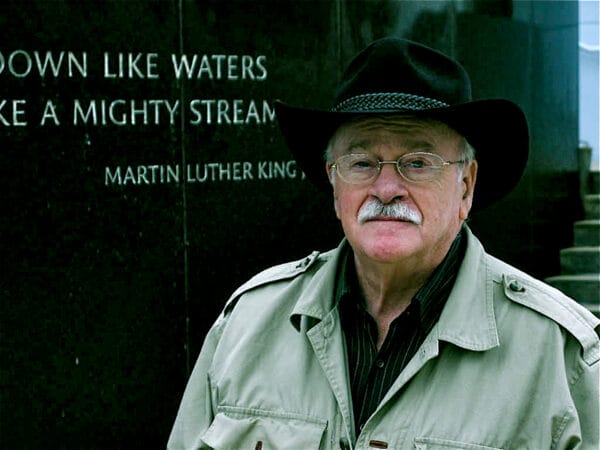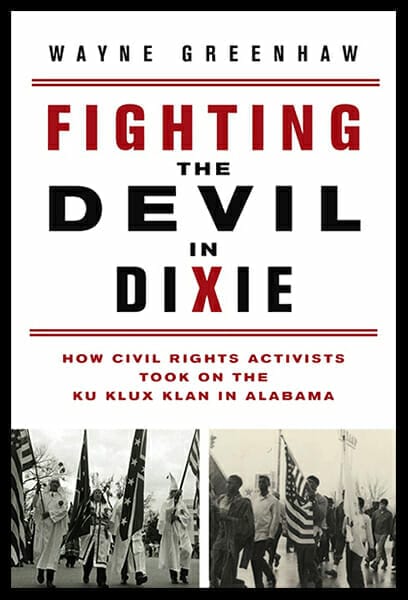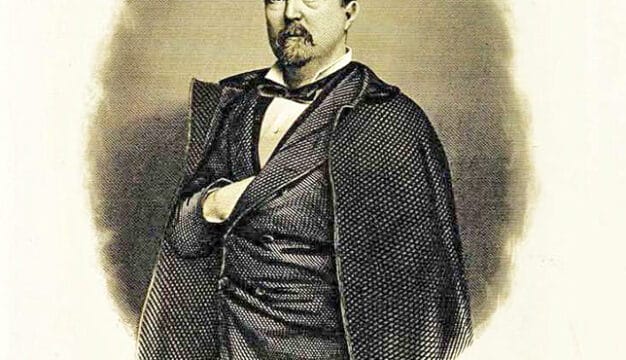Wayne Greenhaw
Writer and poet Wayne Greenhaw (1940-2011) produced a broad spectrum of fiction and nonfiction books, two plays, poetry, travel guides, and scripts for film and television. Greenhaw’s writing reflects strong advocacy of the civil rights movement, expressed vividly through personal reflections. As a journalist in the 1960s, Greenhaw directly witnessed the civil rights movement as it unfolded through his personal association with movement leader E. D. Nixon during the Selma to Montgomery March. As a result, many of his works focused on civil rights. Greenhaw’s writing was not limited to any one style or genre, although he named Harper Lee and several civil rights leaders as his primary influence.
 Wayne Greenhaw in Montgomery
Harold Wayne Greenhaw was born in Sheffield, Colbert County, into a troubled family; he grew up in Trussville and Tuscaloosa. Greenhaw contracted polio as an infant, causing health problems, including a curvature of the spine, that persisted through his teen years. At the age of 14, he underwent major surgery to correct his spine and was confined to a body cast for six months. During that time, he read extensively and learned to love literature. After graduating from high school in Tuscaloosa, Greenhaw moved to Mexico at the age of 18 to study creative writing at the Instituto Allende in San Miguel de Allende in the summer of 1959. He returned to Tuscaloosa and entered the University of Alabama to study writing under English professor Hudson Strode. In 1958, Greenhaw gained part-time employment as a sports reporter for the Tuscaloosa News. He served as sports columnist for the Graphics Weekly from 1963 to 1964 and worked as a writer assigned to an educational project at Draper Correctional Center from 1964 to 1965. He then took a position as a general assignment reporter for the Alabama Journal newspaper in 1965 and completed a bachelor of science in education at the University of Alabama in 1966. His first novel, The Golfer, was published shortly thereafter in 1967.
Wayne Greenhaw in Montgomery
Harold Wayne Greenhaw was born in Sheffield, Colbert County, into a troubled family; he grew up in Trussville and Tuscaloosa. Greenhaw contracted polio as an infant, causing health problems, including a curvature of the spine, that persisted through his teen years. At the age of 14, he underwent major surgery to correct his spine and was confined to a body cast for six months. During that time, he read extensively and learned to love literature. After graduating from high school in Tuscaloosa, Greenhaw moved to Mexico at the age of 18 to study creative writing at the Instituto Allende in San Miguel de Allende in the summer of 1959. He returned to Tuscaloosa and entered the University of Alabama to study writing under English professor Hudson Strode. In 1958, Greenhaw gained part-time employment as a sports reporter for the Tuscaloosa News. He served as sports columnist for the Graphics Weekly from 1963 to 1964 and worked as a writer assigned to an educational project at Draper Correctional Center from 1964 to 1965. He then took a position as a general assignment reporter for the Alabama Journal newspaper in 1965 and completed a bachelor of science in education at the University of Alabama in 1966. His first novel, The Golfer, was published shortly thereafter in 1967.
In 1971, Greenhaw published an article on the My Lai massacre (the mass murder of Vietnamese civilians by members of the U.S. Army during the Vietnam War) that earned him a Nieman Fellowship to study journalism at Harvard University in 1972. He became Jimmy Carter’s press secretary in Alabama during the 1976 presidential campaign. That same year, Greenhaw penned an editorial in the New York Times exposing Alabama white supremacist Asa Carter as the author of The Education of Little Tree, a supposed biography that Carter had written under the pseudonym Forrest Carter. In 1982, he published Elephant in the Cotton Fields: Ronald Reagan and the New Republican South and two years later published Flying High: Inside Big-Time Drug Smuggling. From 1984 to 1988, he was editor and publisher of Alabama Magazine.
 Fighting the Devil in Dixie
Several of Greenhaw’s books center on the state of Alabama and Montgomery in particular. Examples includeAlabama on My Mind: Politics, People, History, and Ghost Stories (1988), Montgomery: Center Stage in the South. A Contemporary Portrait (1990) and Montgomery: The Biography of a City (1994). In 1993, Gov. Jim Folsom appointed Greenhaw as director of the Alabama Bureau of Tourism (now the Alabama Tourism Department). In 1995, Pres. Bill Clinton appointed him as a representative to the White House Conference on Travel and Tourism. That same year, the Southeast Tourism Society named Greenhaw Travel Writer of the Year. Greenhaw continued to write, publishing Alabama: Portrait of a State in 1998 and Beyond the Night: A Remembrance the following year. The latter work is a poignant telling of a young boy’s near-death experience. In 2000, Greenhaw was appointed to the board of directors of the Alabama Humanities Foundation by Gov. Don Siegelman. In 2006, he co-authored with Donnie Williams The Thunder of Angels, which details the struggle for racial equality in Alabama. His writing was augmented by frequent lectures and seminars.
Fighting the Devil in Dixie
Several of Greenhaw’s books center on the state of Alabama and Montgomery in particular. Examples includeAlabama on My Mind: Politics, People, History, and Ghost Stories (1988), Montgomery: Center Stage in the South. A Contemporary Portrait (1990) and Montgomery: The Biography of a City (1994). In 1993, Gov. Jim Folsom appointed Greenhaw as director of the Alabama Bureau of Tourism (now the Alabama Tourism Department). In 1995, Pres. Bill Clinton appointed him as a representative to the White House Conference on Travel and Tourism. That same year, the Southeast Tourism Society named Greenhaw Travel Writer of the Year. Greenhaw continued to write, publishing Alabama: Portrait of a State in 1998 and Beyond the Night: A Remembrance the following year. The latter work is a poignant telling of a young boy’s near-death experience. In 2000, Greenhaw was appointed to the board of directors of the Alabama Humanities Foundation by Gov. Don Siegelman. In 2006, he co-authored with Donnie Williams The Thunder of Angels, which details the struggle for racial equality in Alabama. His writing was augmented by frequent lectures and seminars.
Greenhaw was the recipient of numerous awards and honors, including the Harper Lee Award from the Alabama Writers Conclave and the Hackney Literary Award from Birmingham-Southern College. Greenhaw published several hundred articles in publications ranging from Reader’s Digest to Music City News. Residing in both Alabama and Mexico, he produced works in English and Spanish and found common ground in both places in his writing.
Greenhaw died on May 31, 2011, in Birmingham from complications related to heart surgery. In 2018, he was inducted posthumously into the Alabama Writers Hall of Fame.
Selected Works by Wayne Greenhaw
The Golfer (1967)
“Is Forrest Carter Really Asa Carter? Only Josey Wales May Know for Sure” (1976)
King of Country (1994)
Beyond the Night (1999)
My Heart is in the Earth (2001)
The Thunder of Angels: The Montgomery Bus Boycott and the People Who Broke the Back of Jim Crow (2006)
Fighting the Devil in Dixie: How Civil Rights Activists Took on the Ku Klux Klan in Alabama (2011)
Further Reading
- Best, Ricky, and Jason Kneip. Guide to the Papers of Wayne Greenhaw. Montgomery, Ala.: AUM Library, Archives & Special Collections, 2005.



